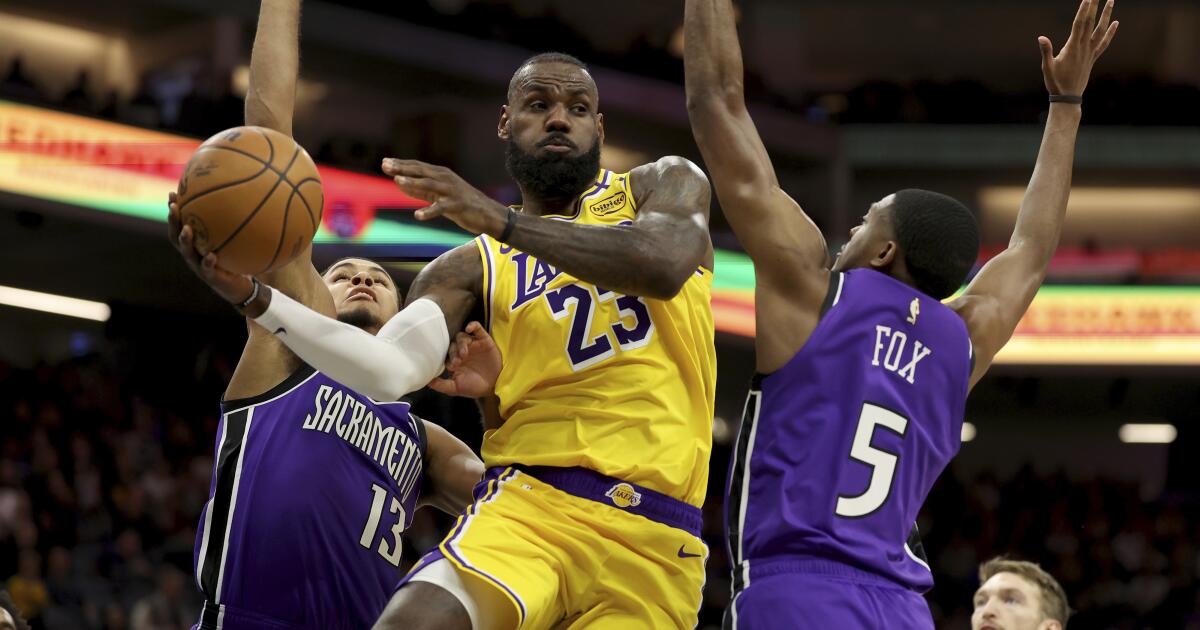SACRAMENTO — Midway through the first quarter Thursday night, LeBron James checked out against the Sacramento Kings, walking to the bench in the city where he played his first NBA regular season minutes more than 21 years ago.
It would be his last walk off the court before achieving another milestone. By the time his next shift ended in the second quarter, he passed Kareem Abdul-Jabbar for the most minutes logged in the regular season, breaking the previous record of 57,446 minutes.
“I just think it’s just a commitment to the craft and to the passion and love I have for the game,” James said about his achievement — one in which he has spent more than 957 hours playing in professional basketball games.
Still, after all that time, James is capable of making winning plays — the chase-down block, the key defensive stop and the bully-ball dagger all playing a role in helping the Lakers defeat the Kings 113-100.
Austin Reaves led the Lakers with 25 points and James had 19 points, six rebounds and seven assists. He ended the game at 57,471 career minutes after playing 34 minutes.
“I’ve been able to do this at a high level over two decades,” James said. “And to continue to put myself in record books in this game of basketball that I love so much and in the best league in the world is pretty cool and it’s very humbling.”
Despite a slow shooting night, Anthony Davis dominated with 21 points, four assists and season highs of 18 rebounds and six blocked shots. Davis also had three steals.
“He was phenomenal tonight,” coach JJ Redick said. “And it just shows you how elite he is as a player that he can have a seven-for-20 night and still dominate a basketball game.”
The minutes record comes at a time when the Lakers and James have been very in touch with how much he has (and hasn’t) been playing. James missed two games and spent a week away from the team, getting a mental and physical reset after his left foot began to bother him.
He returned Sunday against Memphis and had noticeably more energy on both ends of the court. Redick said the team could look for other opportunities to give the soon-to-be 40-year-old more rest.
Speaking before the game, James said, more so than in the past, he could be open to that.
“I’m just not a guy that likes to sit games if I’m somewhat healthy. It doesn’t matter. It’s just, it’s never been my thing,” James said when asked about it. “If there’s an opportunity where it could benefit my body and benefit my play long-term for the better of the team, then I’m always open to having that conversation. So we’ll see what happens.”
The Lakers, who had three days off since their last game, had plenty of energy, using it against the Kings to storm to an early 14-point lead on the backs of their much-improved defense.
With the Kings playing transition defense, the Lakers were able to create tons of open looks from the perimeter, making seven threes in the first quarter alone.
The game tightened in the second, the Kings taking the lead before the Lakers’ best players took control.
Reaves got to the line and hit big shots. Davis out-battled Domantas Sabonis, a player he’s now bested two games in a row. And James controlled the game without dominating the flow of it. Gabe Vincent, who has struggled to shoot the ball since joining the Lakers, hit four threes.
But it was defensively where the Lakers continued to play their best basketball, holding an opponent to 100 points or fewer for the third time in four games.
“I really felt like this might be my favorite win we’ve had all season just because we weren’t efficient offensively,” Redick said. “But because of our crashing, because we limited them in transition, limited them to one shot — like all of the things that we’ve preached that give yourself a chance to win every night if you have an off-shooting night and an off-offensive night — we did tonight.”
James said that he wasn’t thinking about what his accomplishment meant for the future, not even in regard to Saturday’s rematch with the Kings in Sacramento.
“I just set the all-time [record] in minutes,” he said with a smile. “I am not thinking about this next game yet. I’m about to get to this room, drink some wine, play some Madden and chill the f— out.”
Soon there will be another game and more minutes to play, and whatever works, well, it’s worked.
This story originally appeared on LA Times

